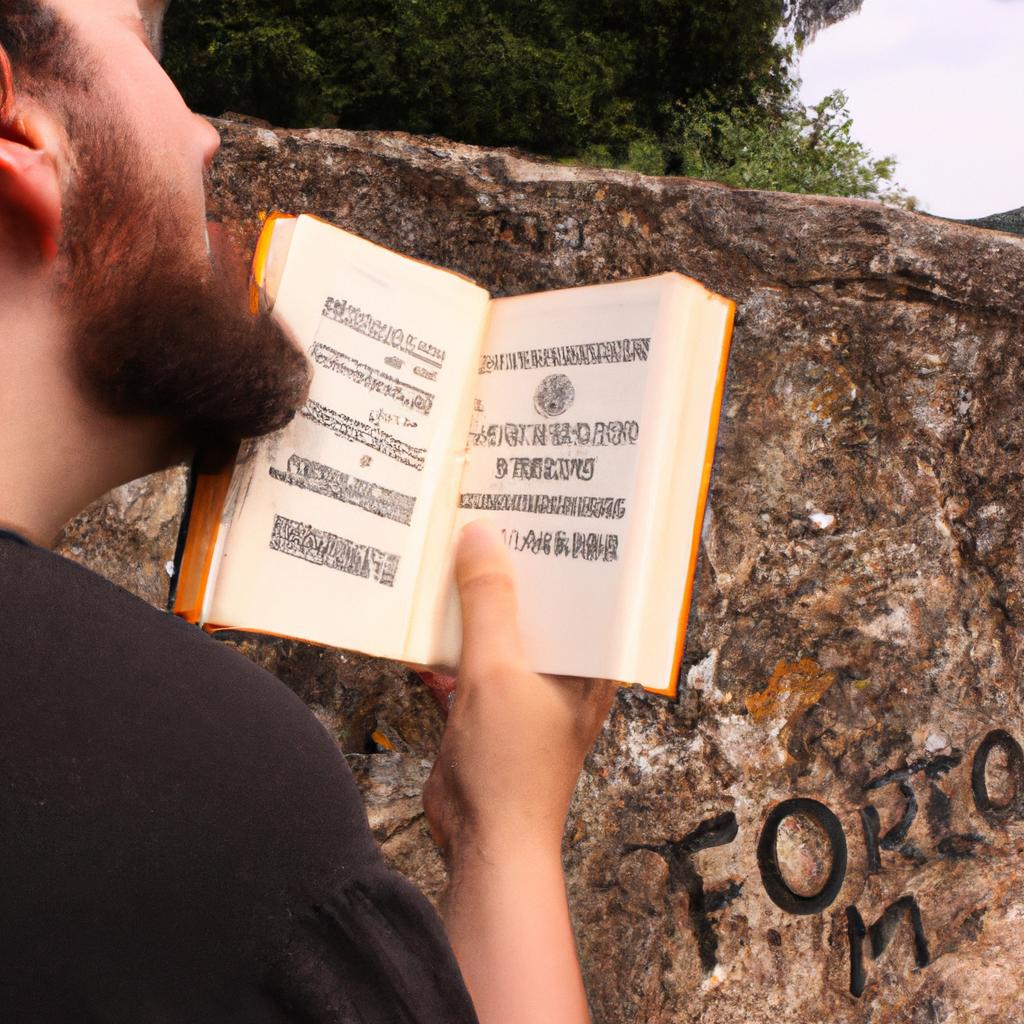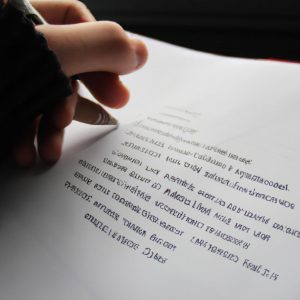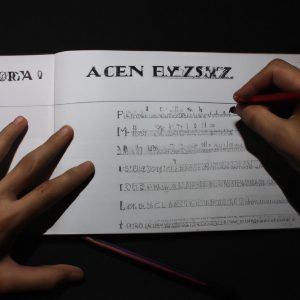Yiddish: Ashkenazi Heritage and Language

Yiddish, a language with deep roots in Ashkenazi Jewish culture, serves as a testament to the rich heritage of Eastern European Jews. Its origins can be traced back to the 9th century when Hebrew and Germanic languages merged among Jewish communities residing in what is now known as Germany. Over time, Yiddish evolved into a distinct linguistic entity that encapsulated the collective experiences and traditions of Ashkenazi Jewry. This article aims to explore the historical significance of Yiddish, highlighting its role as a symbol of cultural identity and resilience.
To illustrate the enduring legacy of Yiddish, let us consider an imaginary scenario: Leah, a third-generation American descendant of Ukrainian Jewish immigrants, discovers an old family diary written entirely in Yiddish. As she embarks on her journey to decipher its content, she not only unravels her ancestors’ personal narratives but also unearths a profound connection to her Ashkenazi roots. Through this anecdote, we glimpse the power that Yiddish possesses in bridging generations and fostering an intergenerational understanding of one’s heritage.
By delving into the exploration of Yiddish’s history and impact within Ashkenazi culture, this article will shed light on how it has impacted various aspects of Ashkenazi Jewish life, including literature, theater, music, and religious practices. Yiddish literature has produced renowned authors such as Sholem Aleichem and Isaac Bashevis Singer, whose works capture the essence of Jewish life in Eastern Europe. Yiddish theater, known as “Yiddishkeit,” flourished in the early 20th century and provided a platform for storytelling, humor, and social commentary. The vibrant Yiddish music scene showcased traditional folk songs and klezmer music, serving as a means of cultural expression and preservation.
Furthermore, Yiddish played a vital role in religious observance among Ashkenazi Jews. Synagogue services were often conducted in Yiddish, enabling congregants to understand and connect with their faith on a deeper level. Yiddish also influenced religious texts and commentaries, with scholars composing extensive works in the language to disseminate knowledge within the community.
Despite experiencing significant challenges throughout history, including persecution during World War II and assimilation pressures in modern times, Yiddish has displayed remarkable resilience. It has managed to maintain its relevance through dedicated efforts by individuals and organizations committed to its preservation. Today, there are ongoing initiatives to teach Yiddish in academic settings and revitalize its use within Jewish communities around the world.
In conclusion, Yiddish serves as a testament to the enduring cultural heritage of Ashkenazi Jews. Its historical significance lies not only in its linguistic development but also in its ability to forge connections across generations and preserve collective memories. By exploring the impact of Yiddish on literature, theater, music, and religion, we gain insight into its profound influence on Ashkenazi culture. As Leah delves into her family’s past through an old diary written in Yiddish, she discovers not just words on paper but a gateway to her ancestors’ experiences and an affirmation of her own identity as an Ashkenazi Jew.
Origins of Yiddish
Origins of Yiddish
Imagine a young Jewish boy named Isaac living in the bustling city of Krakow, Poland, during the 16th century. Isaac’s parents are Ashkenazi Jews who have recently migrated from Germany to escape religious persecution. Despite their best efforts to maintain their Germanic traditions and language, over time, Isaac and his family find themselves gradually adopting a new form of communication: Yiddish.
Yiddish originated in Central Europe during the medieval period as a fusion between Hebrew and various dialects of Middle High German spoken by Jewish communities. This linguistic amalgamation served as a way for Ashkenazi Jews to preserve their cultural heritage while adapting to the evolving socio-political landscape around them. The precise roots of Yiddish remain somewhat elusive due to limited historical documentation; however, it is widely believed that this unique language emerged during the 9th or 10th century CE.
To better understand the origins of Yiddish, let us examine some key factors that contributed to its development:
- Geographical isolation: Jewish communities residing in Eastern European regions such as present-day Germany, Poland, and Russia were often isolated from mainstream society due to discriminatory policies. As a result, they formed close-knit communities where Yiddish became an essential means of communication.
- Linguistic blending: Over time, Jewish speakers incorporated elements from neighboring languages into their speech patterns, resulting in lexical borrowings and grammatical changes within Yiddish. This process allowed for greater adaptability and integration with local cultures.
- Religious influence: Since Judaism places significant importance on preserving tradition and religious texts written in Hebrew, many words related to religious practices found their way into Yiddish vocabulary. This infusion further solidified its connection with Ashkenazi culture.
- Oral transmission: Due to relatively low literacy rates among Ashkenazi Jews until the modern era, much of the Yiddish language was transmitted orally from one generation to the next. This ensured its survival and continued development despite political upheavals and societal changes.
To provide a visual representation of the emotional impact that Yiddish holds for many individuals, consider the following table:
| Emotions Associated with Yiddish | Examples of Expressions in Yiddish |
|---|---|
| Nostalgia | Rachmones (compassion), kvetch (complain) |
| Humor | Mazel tov (good luck), schlep (carry with effort) |
| Love and endearment | Mamele (little mother), bubbeleh (dear grandmother) |
| Resilience | Bashert (meant to be), oy vey! |
The deep-rooted emotions tied to Yiddish reflect its significance as not just a communication tool but also as an embodiment of Ashkenazi heritage. As we delve further into the exploration of this unique language, we will uncover more about its intricate alphabet and writing system.
Transitioning seamlessly into our discussion on the “Yiddish Alphabet and Writing System,” it becomes evident that understanding these fundamental aspects is crucial to comprehending the richness and complexity encapsulated within Yiddish’s linguistic tapestry.
Yiddish Alphabet and Writing System
From the early 10th century to the late 18th century, Yiddish evolved as a distinct language spoken by Ashkenazi Jews in Central and Eastern Europe. Building upon the foundations established in the previous section on the origins of Yiddish, this section will delve deeper into its unique alphabet and writing system. Understanding these aspects is crucial for comprehending how Yiddish has been used as a medium of cultural expression throughout history.
To illustrate the significance of the Yiddish alphabet and writing system, let us consider a hypothetical case study of Sarah, a young Jewish girl living in 16th-century Poland. Sarah’s parents are part of a vibrant Jewish community where Yiddish serves as their primary means of communication. With no formal education available to her at that time, Sarah learns to read and write using the Hebrew script adapted for Yiddish purposes. This example highlights how Yiddish served not only as a linguistic tool but also played an essential role in connecting individuals within their own communities.
The Yiddish writing system employs several distinctive features that set it apart from other languages. One such feature is its extensive use of diacritics, including vowel points known as “nekudes.” These nekudes contribute to precise pronunciation and aid readers who may have limited familiarity with written text. Additionally, unlike English or German alphabets which contain capital letters for proper nouns or sentence beginnings, all letters in the Yiddish alphabet are lowercase. Furthermore, while sharing similarities with both Hebrew and German scripts, certain characters were uniquely developed for Yiddish sounds absent in those languages.
Exploring further nuances of the Yiddish alphabet and writing system reveals its rich historical context:
- The presence of Aramaic influence due to its connection with religious texts.
- Adaptation of Hebrew script through modifications like additional characters representing specific phonetic values.
- Incorporation of German orthographic conventions resulting from centuries of cultural exchange.
- Synthesis of local Slavic languages through the introduction of Cyrillic letters.
By examining these aspects, we gain a profound understanding of how Yiddish has evolved as an amalgamation of linguistic influences and socio-cultural interactions. The subsequent section will delve into the influence of Hebrew and German on Yiddish, shedding light on further layers of its intricate development throughout history.
Influence of Hebrew and German on Yiddish
Yiddish, as a language, is deeply rooted in the Ashkenazi Jewish heritage. Its alphabet and writing system have played a significant role in preserving and transmitting this cultural legacy from generation to generation. Understanding the Yiddish alphabet is crucial for comprehending its unique linguistic features and historical development.
One example that highlights the importance of the Yiddish alphabet is the case of a young Jewish immigrant arriving in America during the late 19th century. Unable to speak English fluently, he relied heavily on his knowledge of the Yiddish alphabet to navigate daily life. This individual’s ability to read and write Yiddish enabled him to connect with other members of his community, find employment within Jewish businesses, and maintain ties with his Ashkenazi heritage.
To further explore the intricacies of the Yiddish alphabet, it is essential to examine its influences from Hebrew and German. The Hebrew script serves as the basis for writing Yiddish, incorporating both consonants and vowels into its character set. However, due to its close proximity with German-speaking regions in Europe where many Jews resided historically, German elements also found their way into the formation of Yiddish words and sounds.
The influence of Hebrew and German on Yiddish can be observed through several key aspects:
- Vocabulary: While primarily based on medieval High German vocabulary, Yiddish incorporates numerous loanwords from Hebrew, Aramaic, Slavic languages (such as Polish or Russian), Romance languages (like Spanish or French), and even English.
- Grammar: While sharing similarities with both Hebrew and German grammar structures, Yiddish developed distinct grammatical rules over time. For instance, it adopted certain declensions from German while drawing upon Hebrew syntax for constructing sentences.
- Phonetics: The pronunciation of various sounds differs between Hebrew-influenced dialects (Litvisher) versus those influenced by Central European dialects (Poylisher). These differences reflect the historical and geographic variations within the Ashkenazi Jewish population.
By understanding the Yiddish alphabet’s origins and influences, one gains insights into how this unique language evolved. The next section will delve deeper into the rich heritage of Yiddish literature and folklore, exploring its contributions to both Jewish culture and world literature as a whole. This exploration reveals not only the linguistic beauty of Yiddish but also its profound cultural significance that continues to resonate today.
Yiddish Literature and Folklore
H2: Influence of Hebrew and German on Yiddish
The influence of both Hebrew and German on the development of Yiddish cannot be understated. These two languages played significant roles in shaping the vocabulary, grammar, and overall structure of Yiddish as we know it today. One example that highlights this linguistic interplay is the adoption of Hebrew words into Yiddish religious texts. This borrowing enriched the lexicon with specialized terms related to Jewish rituals and practices.
One can observe several key aspects regarding the influence of Hebrew and German on Yiddish:
-
Vocabulary Enrichment:
- The incorporation of Hebrew loanwords infused Yiddish with religious terminology.
- Additionally, German contributed a substantial number of non-religious everyday words to the language.
-
Grammatical Adaptations:
- The grammatical structures of both Hebrew and German influenced certain aspects of Yiddish syntax.
- For instance, word order patterns from these languages were assimilated into specific contexts within Yiddish sentences.
-
Cultural Significance:
- The presence of Hebrew elements in religious texts helped maintain a connection to Jewish traditions and identity.
- Likewise, through its similarities to German, Yiddish served as an expression of Ashkenazi heritage within broader European culture.
These influences not only shaped the linguistic landscape but also provided an emotional link for speakers throughout history. To further illustrate their impact, consider the following table depicting selected borrowed words categorized according to their origins:
| Language Origin | Examples |
|---|---|
| Hebrew | Shabbat (Sabbath), mitzvah |
| German | Haus (house), essen (eat) |
By examining such lexical borrowings alongside grammatical adaptations, one gains insight into how different cultures have interacted over time, resulting in a unique fusion like Yiddish. Understanding this intricate relationship sets the stage for exploring the rich tapestry of Yiddish literature and folklore, which showcase the language’s versatility and cultural significance.
As we delve into the realm of Yiddish literature and folklore, it is crucial to acknowledge the historical context in which these works emerged. The Holocaust and its aftermath profoundly impacted both Yiddish-speaking communities and the future trajectory of this remarkable language.
Yiddish in Holocaust and Post-War Era
Yiddish: Ashkenazi Heritage and Language
Transitioning from the rich tapestry of Yiddish literature and folklore, we now explore the harrowing impact that the Holocaust had on this vibrant language. The events during and after World War II forever altered the trajectory of Yiddish, leaving an indelible mark on its speakers and their cultural heritage.
To illustrate the profound effects of the Holocaust on Yiddish-speaking communities, let us consider a hypothetical case study. Imagine a small shtetl nestled deep within Eastern Europe where Yiddish was once spoken joyously by generations. As Nazi forces swept through the region, they dismantled this tight-knit community, robbing it not only of lives but also of its linguistic identity. In one fell swoop, countless stories were silenced as families were torn apart or perished together.
The devastating consequences of the Holocaust forced Yiddish into an era of struggle for survival. Many survivors who clung to their memories sought solace in words, using writing as a form of resistance against oblivion. Despite immense personal loss, these courageous individuals found strength in preserving their heritage through literature, ensuring that future generations would remember those lost to hatred.
This period marked a turning point for Yiddish-speaking communities worldwide, leading to significant changes that shaped its contemporary use:
- Dispersal: The diaspora resulting from the war scattered surviving Yiddish speakers across different continents.
- Assimilation Challenges: Communities faced various assimilation challenges in new countries while striving to maintain their cultural distinctiveness.
- Decline and Resilience: Although facing threats of decline due to shifting demographics and modernization trends, efforts emerged to revitalize interest in learning and speaking Yiddish.
- Cultural Legacy: The collective memory of the Holocaust, intertwined with Yiddish literature and folklore, serves as a testament to the resilience and strength of Ashkenazi Jewish heritage.
As we delve further into the revival and contemporary use of Yiddish in subsequent sections, it becomes evident that this language has not been consigned to history. Through determination and dedication, communities have breathed new life into Yiddish, ensuring its continued relevance for future generations.
Revival and Contemporary Use of Yiddish
Section H2: Revival and Contemporary Use of Yiddish
Having examined the impact of the Holocaust and post-war era on Yiddish, we now turn our attention to its revival and contemporary use. Despite the immense tragedy faced by Ashkenazi Jews during World War II, there have been efforts to revive and preserve their rich linguistic heritage.
Revival Efforts and Cultural Movements:
One notable example that exemplifies the revitalization of Yiddish is the case of Chava Rosenfarb, a renowned Yiddish author whose works gained recognition in both Jewish and non-Jewish literary circles. Born in Poland in 1923, she survived Auschwitz but lost her entire family. After immigrating to Canada, Rosenfarb dedicated herself to writing in Yiddish, even as it was perceived as a dying language. Her commitment not only contributed to the preservation of Yiddish literature but also served as an inspiration for other writers seeking to reconnect with their cultural roots.
Contemporary Use and Importance:
The contemporary use of Yiddish extends beyond just literature; it has become an integral part of various aspects of Jewish identity and culture today. Here are some ways in which Yiddish continues to play an important role:
- Preservation of Oral Traditions: Through storytelling, songs, and theater performances conducted in Yiddish, oral traditions are passed down through generations.
- Educational Initiatives: Many institutions offer academic programs focused on teaching Yiddish language and culture.
- Cultural Events: Festivals celebrating Yiddish music, dance, food, and art bring communities together while fostering pride in their shared heritage.
- Online Communities: The internet has facilitated connections among individuals interested in learning or using Yiddish through online forums, social media groups, and virtual classes.
To fully appreciate the emotional significance surrounding the revival and contemporary use of Yiddish, consider the following:
- Rediscovering lost family histories and personal narratives through Yiddish literature.
- Nurturing a sense of belonging by engaging in cultural practices rooted in Yiddish language and heritage.
- Preserving an endangered language that served as a means of expression for generations past.
- Honoring the resilience and strength of Ashkenazi Jews who managed to maintain their linguistic legacy despite immense adversity.
Emotional Table:
The table below highlights some key aspects regarding the revival and contemporary use of Yiddish:
| Aspect | Description | Emotional Impact |
|---|---|---|
| Cultural Identity | Reinforcement of Jewish identity | Sense of pride |
| Linguistic Heritage | Safeguarding a threatened language | Preservation of ancestral roots |
| Communal Bond | Building connections within Jewish communities | Strengthened sense of belonging |
| Historical Resilience | Celebrating the survival and perseverance | Recognition of collective strength |
In conclusion, the revival and contemporary use of Yiddish demonstrate a remarkable commitment to preserving Ashkenazi heritage. Through literary works, educational initiatives, cultural events, online communities, and more, individuals have found ways to reconnect with their roots. This resurgence not only safeguards an endangered language but also fosters a deep sense of cultural pride among those engaged in its practice. The emotional significance attached to these efforts serves as a testament to the enduring impact of Yiddish on both individual lives and communal identities.



